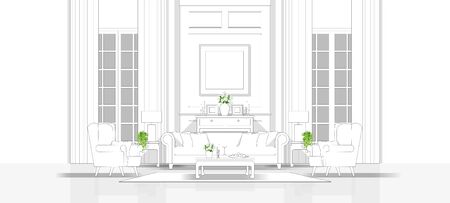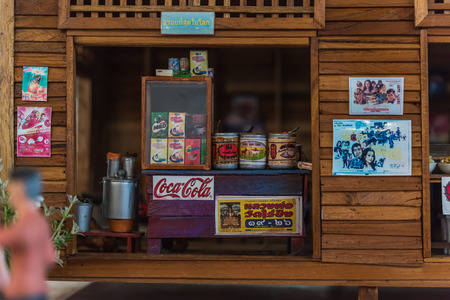The Timeless Charm of the British Countryside
Across the rolling hills, patchwork fields, and ancient woodlands of rural Britain, a sense of enduring beauty shapes both landscape and lifestyle. The British countryside is more than just a picturesque backdrop—it is steeped in centuries-old traditions and an authentic connection to nature. This natural splendour, combined with the region’s deep historical roots, creates a unique atmosphere that consistently inspires rustic interior trends. From honey-coloured stone cottages in the Cotswolds to weathered farmhouses nestled in Yorkshire dales, these landscapes evoke a feeling of warmth, comfort, and understated elegance. It is this timeless charm that encourages homeowners and designers alike to bring elements of rural tranquillity indoors, blending natural textures, earthy colours, and traditional craftsmanship to craft interiors that reflect the serene spirit of Britain’s countryside.
2. Incorporating Natural Materials Inspired by the Landscape
Drawing inspiration from the rolling hills, lush woodlands, and charming stone cottages of the British countryside, rustic interior trends in the UK have increasingly embraced locally sourced materials. These elements not only capture the authentic spirit of rural Britain but also offer a tactile connection to nature within the home. By utilising regional wood, natural stone, and traditional textiles, homeowners are able to reflect the enduring textures and earthy tones found in their surroundings.
Local Wood: From Oak Beams to Reclaimed Floorboards
The use of local timber is a defining feature of countryside-inspired interiors. English oak, ash, and elm are often chosen for their robust character and natural grain, echoing the age-old forests that dot the landscape. Whether exposed as ceiling beams or crafted into bespoke furniture, these woods add warmth and structural authenticity to any space.
| Wood Type | Common Uses | Countryside Connection |
|---|---|---|
| English Oak | Beams, flooring, tables | Symbolic of British woodland heritage |
| Ash | Chairs, cabinetry | Abundant in hedgerows and native copses |
| Elm | Doors, paneling | Historically used in rural structures |
Natural Stone: Bringing Rural Foundations Indoors
Countryside homes often showcase rugged stonework—be it Cotswold limestone or Welsh slate—that tells the story of local geology. These materials are now being brought inside through features such as flagstone floors, fireplace surrounds, and accent walls. Their organic textures mirror dry-stone walls and pathways winding through rural villages.
| Stone Type | Interior Application | Regional Heritage |
|---|---|---|
| Cotswold Limestone | Flooring, hearths, wall cladding | Cotswolds region; golden hues reflect local fields |
| Welsh Slate | Kitchens, bathroom tiles, roofing indoors | Wales; renowned for durability and deep colouration |
| Sandstone | Mantelpieces, entryways | Northern England; rustic texture matches landscape paths |
Textiles: Weaving Countryside Comfort Into Homes
No rustic interior is complete without textiles that evoke the softness and comfort of rural life. Wool throws from Yorkshire mills, linen cushions reminiscent of wildflower meadows, and hand-woven rugs all pay homage to British craftsmanship and agricultural tradition. These fabrics not only provide warmth but also introduce subtle patterns and colours derived from the countryside palette.

3. Embracing Traditional British Craftsmanship
The resurgence of handcrafted furnishings and decorative pieces is a defining element in today’s rustic interior trends, deeply rooted in the traditions of the British countryside. Across the UK, there is a renewed appreciation for artisanal skills—whether it’s locally woven textiles, hand-carved oak chairs, or bespoke pottery—that echo generations of rural handiwork. This revival not only honours heritage but also brings a sense of authenticity and character to modern homes. Handcrafted items often tell their own stories; each piece bears subtle imperfections and marks left by its maker, creating a tangible connection to Britain’s craft legacy.
Incorporating these traditional pieces into interiors reflects both pride in regional artistry and an eco-conscious desire to support local artisans. Whether it’s a Welsh wool throw draped over a weathered Chesterfield sofa or a set of hand-thrown mugs from a Cornish potter, these details lend warmth and individuality that mass-produced goods simply can’t replicate. The British countryside’s enduring values—resourcefulness, patience, and respect for natural materials—are translated into every lovingly made furnishing. This movement towards craftsmanship encourages homeowners to invest in quality over quantity, selecting timeless objects that grow more beautiful with age and use.
4. Muted Colour Palettes and Pastoral Tones
One of the most distinctive ways the British countryside shapes rustic interior trends is through its muted colour palettes and gentle, pastoral tones. The rolling fields, mossy woodlands, and ever-changing skies of rural England have inspired a love for earthy hues, soft greens, and warm neutrals in British homes. These colours evoke a sense of tranquillity and timelessness, perfectly capturing the understated elegance of the countryside.
The Appeal of Earthy Hues
Earthy hues such as clay, taupe, and ochre are increasingly favoured in rustic interiors. These shades mirror the natural elements found across the English landscape, from rich soil to weathered stone walls. Their subtle warmth brings depth and comfort to living spaces without overwhelming the senses.
Soft Greens: A Nod to Nature
Soft greens are another staple of countryside-inspired interiors. Reminiscent of hedgerows, meadows, and leafy canopies, these tones connect indoor spaces with the calming presence of nature outside. Popular choices include sage, olive, and muted mint, all of which offer a refreshing yet soothing backdrop for daily life.
Warm Neutrals for Timeless Charm
Warm neutrals like cream, beige, and light grey form the foundation of many rustic schemes. They reflect the misty mornings and gentle sunlight so typical of Britain’s rural vistas. These shades not only enhance natural light but also create a welcoming atmosphere that feels both lived-in and refined.
Popular Countryside-Inspired Colours
| Colour Name | Inspired By | Effect on Interior |
|---|---|---|
| Sage Green | Woodland Foliage | Calming & Restorative |
| Clay Taupe | Earthy Soil | Grounding & Warm |
| Cream White | Misty Mornings | Brightening & Inviting |
| Pebble Grey | Stone Walls & Paths | Subtle & Versatile |
| Ochre Yellow | Harvest Fields | Cosy & Uplifting |
The continued popularity of these muted palettes speaks to a collective desire for interiors that feel harmonious with their surroundings. By echoing the colours found in fields, forests, and skies, homeowners create spaces that celebrate the unique beauty of the British countryside while fostering relaxation and comfort indoors.
5. Vintage Finds and Upcycling in British Homes
The charm of the British countryside is often reflected in the interiors of rural and urban homes alike, thanks to a deep-rooted appreciation for vintage finds and upcycling. Britons have a distinctive knack for blending antique furniture, reclaimed wood, and salvaged materials into their rustic spaces. This practice not only pays homage to traditional craftsmanship but also aligns with contemporary values of sustainability. Whether it’s an old pine dresser discovered at a village market or a weathered barn door repurposed as a dining table, these pieces infuse rooms with history and character. The mix of time-worn textures and natural finishes echoes the layered beauty of the landscape itself, while celebrating resourcefulness and individuality. By giving new life to preloved items, British homeowners create warm, inviting environments that feel both timeless and personal—an approach that continues to inspire rustic interior trends across the UK.
Seasonal Changes and Cosy Details
The ever-shifting British seasons have a profound influence on the way rustic interiors are styled and enjoyed throughout the year. As the countryside landscape transitions from the fresh blossoms of spring to the golden warmth of autumn, so too do the layers, textures, and comforts found in homes across the UK. In spring and summer, lighter linens and breathable cotton throws reflect the airy freshness of blooming meadows, while soft pastel cushions echo the wildflowers dotting hedgerows. As autumn arrives with its crisp air and vibrant foliage, rustic interiors embrace thicker woollen blankets, tartan patterns, and plush rugs underfoot—mirroring the woodland’s rich hues and inviting warmth against chilly evenings. Winter brings a desire for even more comfort: heavy knit throws, sheepskin accents, and deep velvets create a sanctuary that echoes both practicality and tradition, reminiscent of country cottages sheltering against frosty mornings. These thoughtful layers not only add tactile comfort but also evoke a sense of continuity with nature’s cycles outside. The quintessentially British habit of preparing for every weather—rain or shine—is reflected indoors by keeping baskets of blankets at hand, stacking logs by the hearth, and dressing sofas with snug cushions ready to sink into after a bracing walk across muddy fields. In this way, seasonal changes in the British countryside don’t just inspire interior trends—they encourage an ongoing relationship between home life and the landscape beyond the window, making comfort and cosiness intrinsic to rural-inspired living.

